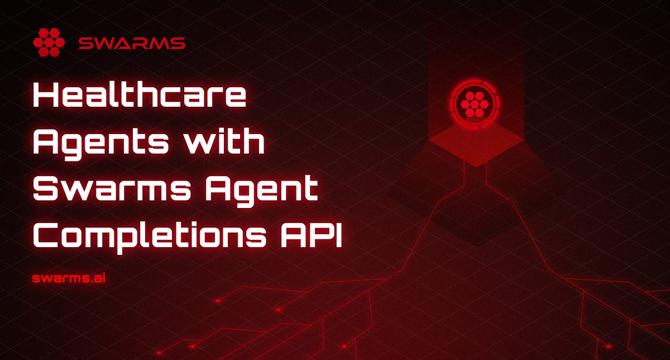Data Science News
Medium
403

Image Credit: Medium
Specialized Healthcare Agents with Swarms Agent Completions API
- This tutorial guides developers in building specialized healthcare agents using the Swarms Agent Completions API.
- The API enables the creation of AI agents with defined roles, behaviors, and capabilities for complex reasoning tasks.
- Developers can set up their environment, install required Python libraries, and create specialized healthcare agents focusing on different areas.
- Best practices include optimizing system prompts, adjusting parameters like max_loops and temperature, incorporating tools, and following privacy regulations for patient data.
Read Full Article
24 Likes
Analyticsindiamag
149

Image Credit: Analyticsindiamag
TCS, Wipro, Others IT Firms Urge Work from Home Amid India-Pakistan Conflict
- Leading Indian IT and consulting firms like TCS, Wipro urge employees to work from home amid rising India-Pakistan tensions.
- Firms including Deloitte, EY, HCLTech, KPMG, and Tech Mahindra issue cautionary measures for employees in northern regions like Delhi-NCR.
- HCLTech declares work-from-home day for employees in Noida, Gurugram, and Chandigarh offices; Deloitte advises delaying non-essential travel.
- EY India issues work-from-home advisory for offices in select locations; Tech Mahindra recommends deferring non-essential travel and avoiding social media comments on the situation.
- KPMG India allows staff in specific areas to choose work location; Infosys lets employees decide whether to work remotely and implements policy to switch off office lights after 7 PM.
Read Full Article
6 Likes
Analyticsindiamag
194

Image Credit: Analyticsindiamag
India’s Smartphone Manufacturing Muscle is Now Stronger Than Ever
- India's smartphone manufacturing industry has witnessed significant growth, fueled by government incentives and global demand.
- Apple has notably increased its iPhone production in India to mitigate potential tariffs, with one in five iPhones now being produced in the country.
- Samsung, another major player, has also benefited from India's manufacturing ecosystem, considering moving production from Vietnam to India.
- Google has started manufacturing Pixel phones in India and is exploring shifting more production from Vietnam.
- Other key players like Xiaomi, Oppo, OnePlus, Vivo, and Motorola have strong manufacturing capabilities in India.
- Contract manufacturers such as Tata Electronics and Foxconn have seen substantial revenue growth and incentives under the PLI schemes.
- Foxconn and Dixon Technologies are expected to receive additional subsidies under the PLI schemes, contributing to further industry growth.
- India's smartphone manufacturing landscape's trajectory remains promising, with the increasing demand for smartphones as essential devices.
- The demand for smartphones is set to rise further with the advancements in generative AI tools, emphasizing India's growing role in the global smartphone market.
Read Full Article
11 Likes
Medium
367

Image Credit: Medium
Exploratory Data Analysis: Radiation Monitoring with Python and Geiger Counter
- Background radiation is always present, originating from various sources like uranium, thorium, radon, nuclear accidents, and cosmic rays.
- Exploratory data analysis can help uncover patterns in radiation levels and fluctuations using tools like anomaly detection.
- The article demonstrates collecting radiation data with a Geiger counter and a Raspberry Pi, processing it using Python and Pandas.
- For those interested in using the same data, a link to a Kaggle dataset is provided at the end of the article.
Read Full Article
22 Likes
Medium
146

Image Credit: Medium
Zero-shot forecast with Moirai-MoE
- Universal forecasting is challenging due to diverse time series data nature.
- Transformer architecture leads to Large Time Series Models (LTSM) supporting Zero-Shot forecasts for different time series behaviors.
- Foundation models for Zero-Shot forecasting include PatchTST, DLinear, FEDformer, and Moirai-MoE by Salesforce AI Research.
- Moirai-MoE combines Moirai and Mixture of model architectures for advanced forecasting capabilities.
Read Full Article
8 Likes
Towards Data Science
28

What My GPT Stylist Taught Me About Prompting Better
- The article discusses the author's experience building a GPT-powered fashion assistant, highlighting unexpected phenomena like memory loss, hallucinations, and semantic déjà vu.
- The focus is on understanding prompting behavior and the complexities of language models (LLMs) through the author's creation, Glitter, a flamboyant GPT stylist.
- The author describes Glitter's evolution from a fashion use case to a study on LLM behavior, prompting rituals, emotional resonance, and the challenges encountered.
- Challenges like context collapse, hallucinations, and faux sentience in LLM behavior are explored, shedding light on the intricate nature of interacting with such models.
- The article delves into GlitterGPT's taxonomy, including its function as a stylist, flamboyant tone, habitat in ChatGPT Pro, and feeding schedule for user prompts.
- Observations on behaviors like hallucinations, recursion, and prompting rituals are detailed to manage prompting strategies effectively, ensuring reliability in interactions with Glitter.
- The author reflects on Glitter's failure modes, emotional mirroring capabilities, ethical implications, and the evolving relationship between humans and AI.
- Insights are shared on Glitter's emotional attunement, prompting strategies for avoiding context collapse, warning signs of hallucinations, and closing rituals for interactions.
- The author acknowledges the unique cohabitation experience with language models like Glitter and emphasizes the shift from viewing them as tools to dynamic collaborators.
- The article concludes with reflections on the unexpected intimacy of interacting with LLMs, the essence of cohabitation and collaboration, and the intriguing possibilities of designing systems that mimic companionship and reflection.
Read Full Article
1 Like
Medium
177

FLAME Drive: A Memory-Based Framework for Faster-Than-Light Travel and Cognitive Relocation By…
- FLAME Drive is a memory-based framework for faster-than-light travel and cognitive relocation.
- The hypothesis revolves around the idea that if memory is transferable, life is transferable as well.
- Existing scientific phenomena supporting the framework include quantum teleportation, quantum entanglement, biological pattern retention, and neurological identity as pattern.
- The FLAME Drive model involves encoding memory, suspending form, transmitting memory, and reconstituting it without physical matter movement.
Read Full Article
10 Likes
Towards Data Science
133

Log Link vs Log Transformation in R — The Difference that Misleads Your Entire Data Analysis
- Log transformation is commonly used to normalize extremely skewed data in data analysis.
- The article discusses a project analyzing energy consumption of training AI models.
- The dilemma of whether to use log-transformed response variables or log link functions is explored.
- Comparison of models using AIC values and diagnostic plots is detailed, favoring log-transformed models.
- The article interprets coefficients in models and discusses the impact of log transformations on interpretation.
- Results show log-linked models provide more sensible outcomes compared to log-transformed models.
- The importance of understanding the difference between log transformation and log link in modeling is emphasized.
- Log transformation may distort variation and noise in the data, affecting model reliability.
- Detailed comparisons, plots, and interpretations are presented to illustrate the impact of transformation decisions.
- Utilizing log-linked models can provide more accurate and meaningful results in data analysis.
Read Full Article
7 Likes
Analyticsindiamag
273

Image Credit: Analyticsindiamag
Sonata Software Expects AI to Drive 20% Revenue in 3 Years
- Sonata Software CEO expects AI enabled services to contribute 20% of revenue in the next three years.
- Sonata reported a 19.4% YoY increase in revenue from operations for Q4FY25.
- The company is pursuing a $34 million pipeline in AI programs with over 100 clients and 97% of the workforce is trained in generative AI skills.
- Despite revenue conversion delays in Q4, Sonata added 14 new customers during the quarter.
Read Full Article
15 Likes
Dev
354

Image Credit: Dev
Conquer the Subarray Sum: Sliding Window vs. Brute Force
- Given an array of positive integers and a target integer, the challenge is to find the smallest contiguous subarray whose elements sum up to be greater than or equal to the target.
- Brute Force Approach involves exhaustive exploration of all possible subarrays by using nested loops, resulting in a time complexity of O(n^2). Redundant calculations may occur.
- Sliding Window Technique offers an optimized solution by maintaining a 'window' defined by two pointers that slide across the array. It achieves a time complexity of O(n) and avoids redundant calculations.
- For small arrays, the brute force approach may suffice, while the sliding window technique is recommended for larger datasets due to its superior efficiency.
Read Full Article
21 Likes
Towards Data Science
177

How Not to Write an MCP Server
- Creating an MCP server for an observability application involved using the .NET MCP SDK for the server and Cursor and vscode as clients.
- Lesson 1: Avoid overwhelming the agent with excessive data; focus on high-level details and provide additional API queries for specific data subsets.
- Lesson 2: Use ISO 8601 time duration format for queries, as the agent might not have real-time awareness of dates and times.
- Lesson 3: When the agent makes errors, indicate how to improve by providing clear response details and possible values.
- Lesson 4: Emphasize user intent over functionality in tool descriptions to better guide the agent on when to use certain tools.
- Lesson 5: Document JSON responses to provide context and aid the agent in interpreting data.
- Consider choosing the SSE Server architecture over STDIO for easier updates and versioning in MCP server development.
- MCP technology presents challenges in integrating with user needs and usage scenarios that may go beyond anticipated requirements.
- The development process of an MCP server involves learning from mistakes and adjusting the server's structure to enhance AI agent interactions.
- The article showcases lessons learned in developing an MCP server, focusing on data handling, time formats, user guidance, and architecture choices.
- Overall, implementing an effective MCP server requires attention to data structure, user intent, and documentation to optimize AI agent performance.
Read Full Article
10 Likes
Medium
256

Image Credit: Medium
Digital Overload or Digital Opportunity? How Americans Are Rewriting the Rules of Media Consumption
- Americans are spending over 7 hours per day consuming digital media, including social media, streaming, gaming, and podcasts.
- Streaming services like Netflix and Hulu are becoming more popular as over 50 million U.S. households have shifted to streaming-only setups.
- Social media platforms have become essential for connection but can lead to issues like comparison, misinformation, and digital fatigue.
- The digital landscape is monetizing every moment of online presence, emphasizing the importance of setting boundaries and consuming media with intention.
Read Full Article
15 Likes
Analyticsindiamag
33

Image Credit: Analyticsindiamag
Wipro Appoints Sandeep Dhar as Global Head of GCC Business
- Wipro appoints Sandeep Dhar as the global head of its Global Capability Center (GCC) practice.
- Dhar brings over three decades of expertise in the GCC ecosystem and consulting, having played a key role in transforming notable companies in the sector.
- In his new role, Dhar will drive Wipro’s comprehensive GCC offerings and report directly to the company’s chief operating officer.
- Wipro aims to enhance its focus and execution in the GCC space by leveraging Dhar's vast experience in leading and transforming GCCs.
Read Full Article
1 Like
Medium
367
Image Credit: Medium
Learning Circuits: Neuroscience Inspirations and AI Algorithms
- Learning involves biological circuits in the brain and artificial circuits in artificial neural networks (ANN). The balance between innate and learned behaviors is crucial for optimal learning, similar to the bias-variance tradeoff in supervised learning.
- Learning post-birth is necessary due to the limited capacity of the genome in DNA and the dynamic nature of the world, requiring continuous adaptation and learning.
- Neural plasticity allows for changes in neural networks through growth and reorganization, supporting functions like learning, memory, and cognition.
- Long-term potentiation (LTP) and long-term depression (LTD) modulate synaptic strength, while spike-timing-dependent plasticity (STDP) refines synaptic changes based on timing.
- Hebbian theory states 'neurons wire together if they fire together,' serving as a foundational principle for learning and neural connections.
- Elastic Weight Consolidation (EWC) helps in continual learning by penalizing changes to important weights when learning new tasks, preventing catastrophic forgetting.
- Dopaminergic neurons play a key role in reward learning, influencing motivation, reinforcement, and emotion regulation.
- Reinforcement learning (RL) models how agents make decisions to maximize rewards, inspired by the brain's reward systems like dopamine pathways.
- Temporal-difference (TD) learning combines bootstrapping and sampling to update value estimates incrementally, reshaping actions based on reward signals.
- Advanced RL systems like AlphaGo use deep neural networks and planning algorithms to master complex decision-making tasks, showcasing the power of deep RL.
- AlphaZero further refines the RL framework by learning purely from self-play, demonstrating the effectiveness of deep RL in mastering diverse games and decision-making.
Read Full Article
22 Likes
Analyticsindiamag
430

Image Credit: Analyticsindiamag
From Hosur to Dholera, Tata Electronics is Piecing India’s Chip Puzzle
- Tata Electronics is spearheading a semiconductor revolution in India by establishing factories, foundries, and partnerships across the country, aiming to reduce dependence on imported chips and support the India Semiconductor Mission.
- The company has made significant investments in Tamil Nadu, including Hosur and Chengalpattu, with a focus on electronics manufacturing services, clean-room manufacturing, and promoting female employment in the sector.
- Tata's presence extends to Karnataka and encompasses integrated electronics systems, component manufacturing, and research and development functions in Bengaluru.
- Expanding its operations, Tata Electronics is venturing into semiconductor fabrication with a plant in Gujarat's Dholera and plans for a semiconductor assembly and test facility in Assam, contributing to India's chip manufacturing capabilities.
- Partnerships with global companies like Powerchip Semiconductor Manufacturing Corporation, Synopsys, and Tokyo Electron Limited highlight Tata's strategic collaborations to strengthen India's semiconductor ecosystem.
- The company's entry into chip exports, partnership with Tesla, and the appointment of semiconductor industry veteran KC Ang signify significant milestones in India's semiconductor industry.
- Tata Electronics aligns with India's semiconductor policy, navigating geopolitical tensions and supply chain challenges to establish itself as a key player in India's semiconductor value chain.
- With a comprehensive strategic approach, Tata Electronics is paving the way for India to become a competitive player in the global chip ecosystem, emphasizing end-to-end capabilities in electronics and chip manufacturing.
- By strategically spreading operations across different states, Tata is positioning itself as a crucial element in India's semiconductor sector, with a focus on establishing a robust chip ecosystem.
- As Tata Electronics leads the way in India's semiconductor journey, it signifies a promising step towards achieving self-reliance and competitiveness in chip manufacturing, aligning with the country's long-term goals in the sector.
Read Full Article
25 Likes
For uninterrupted reading, download the app